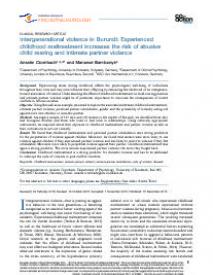Intergenerational violence in Burundi: Experienced childhood maltreatment increases the risk of abusive child rearing and intimate partner violence
Background: Experiencing abuse during childhood affects the psychological well-being of individuals throughout their lives and may even influence their offspring by enhancing the likelihood of an intergenerational transmission of violence. Understanding the effects of childhood maltreatment on child-rearing practices and intimate partner violence might be of particular importance to overcome the consequences of violent conflicts in African societies.
Objective: Using Burundi as an example, we aimed to explore the associations between childhood maltreatment, intimate partner violence, perceived partner intimidation, gender and the probability of violently acting out against one's own children or romantic partner.
Methods: Amongst a sample of 141 men and 141 women in the capital of Burundi, we identified those who had biological children and those who lived or had lived in relationships. Using culturally appropriate instruments, we enquired about their exposure to childhood maltreatment and partner violence as well as their inclinations to act out violently.
Results: We found that childhood maltreatment and perceived partner intimidation were strong predictors for the perpetration of violence against children. Moreover, we found that women were more likely to use violence against children if they experienced partner violence and less likely to resort to violence if they felt intimidated. Men were more likely to perpetrate violence against their partner. Childhood maltreatment was again a strong predictor. The more women experienced partner violence, the more they fought back.
Conclusions: Childhood maltreatment is a strong predictor for domestic violence and has to be addressed to interrupt the cycle of violence in post-conflict countries.
Geachte bezoeker,
De informatie die u nu opvraagt, kan door psychotraumanet niet aan u worden getoond. Dit kan verschillende redenen hebben,
waarvan (bescherming van het) auteursrecht de meeste voorkomende is. Wanneer het mogelijk is om u door te verwijzen naar de bron
van deze informatie, dan ziet u hier onder een link naar die plek.
Als er geen link staat, kunt u contact opnemen met de bibliotheek,
die u verder op weg kan helpen.
Met vriendelijke groet,
Het psychotraumanet-team.
Reference:
Anselm Crombach, & Manassé Bambonyé | 2015
In: European journal of psychotraumatology, ISSN 2000-8066 | 6 | 26995
http://www.ejpt.net/index.php/ejpt/article/view/26995
In: European journal of psychotraumatology, ISSN 2000-8066 | 6 | 26995
http://www.ejpt.net/index.php/ejpt/article/view/26995


